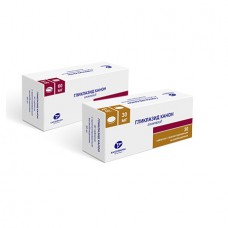Expiration date: 06/2025
Dosage form:
tablets extended release.
Composition
Dosage 30 mg
1 tablet contains:
Active ingredient: gliclazide 30 mg;
Other ingredients: hypromellose (hydroxypropylmethyl-
cellulose) 50 mg, silica colloidal anhydrous 3.5 mg, mannitol 10 mg, magnesium stearate 1.8 mg, hydrogenated vegetable oil, 3.6 mg, microcrystalline cellulose of 81.1 mg.
Dosage 60 mg
1 tablet contains:
Active substance: gliclazide 60 mg;
Other ingredients: hypromellose (hydroxypropylmethyl-
cellulose) 100 mg colloidal silicon dioxide 7 mg and mannitol 80 mg magnesium stearate 3.6 mg, hydrogenated vegetable oil, 7.2 mg, cellulose microcrystalline 102,2 mg.
Description
Round biconvex tablets (dose 30 mg); tablets round
lenticular with valium (dosage of 60 mg), white or nearly white. The slight marbling.
Pharmacotherapeutic group:
hypoglycemic agent for oral administration of sulfonylureas II generation.
Pharmacodynamics
Gliclazide is a derivative of the sulfonylurea hypoglycemic drug for oral administration, which differs from similar products by the presence of N-containing heterocyclic ring with endotoksicski communication.
Gliclazide reduces blood glucose concentrations by stimulating insulin secretion from the beta cells of the islets of Langerhans. Increasing the concentration of postprandial insulin and C-peptide persisted after 2 years of therapy.
In addition to the impact on carbohydrate metabolism gliclazide has hemovascular effects.
Effect on insulin secretion
Diabetes type 2 diabetes gliclazide restores the early peak of insulin secretion in response to glucose intake and increases second phase insulin secretion. A significant increase in insulin secretion observed in response to stimulation caused by the ingestion or administration of glucose.
Hemovascular effects
Gliclazide reduces the risk of thrombosis of small vessels, affecting the mechanisms that can result in the development of complications of diabetes: a partial inhibition of aggregation and adhesion of platelets and decreased concentration of factors of platelet activation (beta-thromboglobulin, thromboxane B2) and also for the restoration of fibrinolytic activity of vascular endothelium and increased activity of tissue plasminogen activator. Intensive glycemic control based on the use of gliclazide extended release (target glycosylated hemoglobin (HbAlc) < 6.5 percent) significantly reduces the risk of micro - and macrovascular complications of diabetes mellitus type 2, in comparison with the standard glycemic control (the ADVANCE study).
Pharmacokinetics
Suction
After oral gliclazide is completely absorbed. Eating does not affect the extent of absorption. The concentration of gliclazide in plasma increases gradually, reaching a maximum and going on a plateau after 6-12 hours. Individual variability is relatively low. The relationship between the adopted dose and the concentration curve of the drug in plasma is a linear dependence on time.
Distribution
The plasma protein binds about 95% of the drug. Gliclazide is metabolized primarily in the liver and excreted mainly by the kidneys. The volume of distribution is approximately 30 liters.
Taking the drug at a dose of 30 mg once a day maintains the effective concentration of gliclazide in plasma over 24 hours.
Metabolism
Gliclazide is metabolized primarily in the liver. Active metabolites in plasma are absent.
Excretion
Excretion is mainly by the kidneys as metabolites, less than 1% is excreted unchanged. The half-life of gliclazide is an average of 16 hours (12 to 20).
Special populations
The elderly clinically significant changes in pharmacokinetic parameters are observed.
Indications for use
Diabetes type 2 the lack of effectiveness of diet, physical activity and weight loss.
Prevention of complications of diabetes: reducing the risk of microvascular (nephropathy, retinopathy) and macrovascular complications (myocardial infarction, stroke) in patients with diabetes type 2 diabetes through intensive glycemic control.



